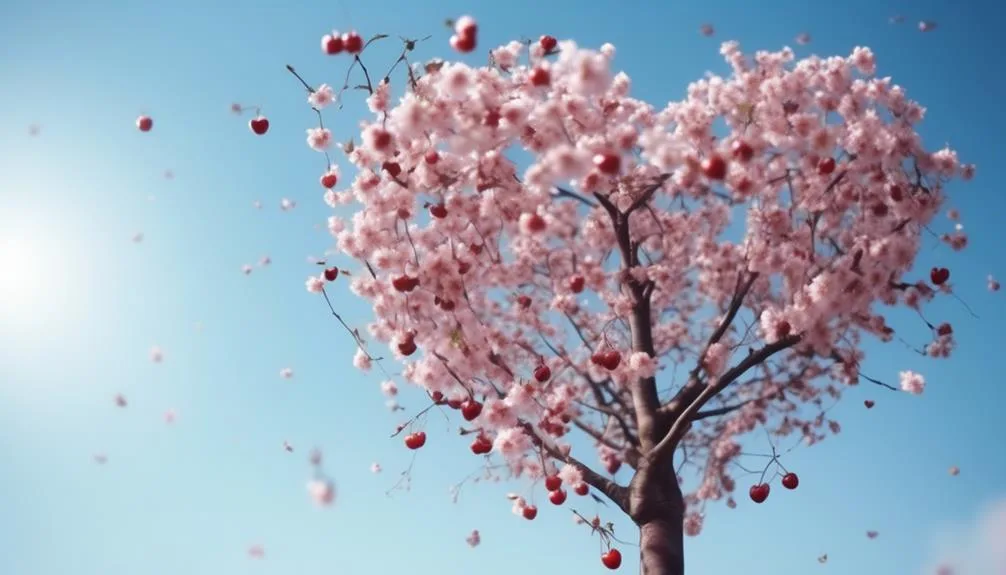Cherry trees can be shaped into various forms, adding a unique touch to your garden or landscape. Whether you want a playful, rounded canopy or a more formal look, pruning cherry trees can enhance your outdoor space.
However, it's important to consider specific techniques and factors before starting. If you're interested in transforming your cherry trees into eye-catching shapes, there's much to learn about the art of cherry tree pruning.
Cherry Trees: Pruning Possibilities
When considering pruning possibilities for cherry trees, it's important to understand the various shapes and forms that can be achieved to enhance their beauty and health.
Artistic pruning techniques can transform ornamental cherry trees, creating stunning focal points in gardens or landscapes. By carefully shaping the branches and foliage, you can create unique forms such as the 'weeping' style, where the branches cascade gracefully, or the 'upright' form, which presents a more columnar appearance.
Additionally, the 'layered' style creates a tiered effect, adding depth and interest to the tree's silhouette. Each of these forms not only adds visual appeal but also promotes the tree's overall health by encouraging proper air circulation and sunlight exposure.
Understanding these pruning possibilities allows you to unleash the full potential of your ornamental cherry trees.
Best Shapes for Cherry Tree Pruning
To achieve the best shapes for pruning your cherry trees, consider the various forms such as 'weeping', 'upright', and 'layered' that can be achieved through artistic pruning techniques. Each shape offers its own unique aesthetic appeal and can complement different garden styles.
Here are some of the best shapes for cherry tree pruning:
- Weeping: This shape creates a graceful and cascading effect, with branches hanging downwards, often resembling a waterfall of flowers.
- Upright: An upright shape gives the tree a tall and straight appearance, making it a great choice for formal gardens or where space is limited.
- Layered: This shape creates a multi-tiered effect, with distinct horizontal layers of branches, adding visual interest to the tree.
- Open Center: This shape involves removing the central leader to create an open and airy canopy, allowing for better light penetration and air circulation.
Techniques for Shaping Cherry Trees
For shaping cherry trees, employing various pruning techniques can help you achieve the desired form and structure while promoting healthy growth and fruit production.
Artistic pruning, also known as tree sculpting, involves carefully trimming and training the branches to create unique and aesthetically pleasing shapes. This technique allows for creative landscaping and cherry tree design, adding visual interest to gardens and outdoor spaces.
One method of artistic pruning is the use of espalier, where the tree is trained to grow flat against a wall or trellis, creating a beautiful and space-saving display.
Another technique involves carefully shaping the tree to mimic natural forms or creating intricate designs.
Factors to Consider Before Pruning
Before starting the pruning process, it's crucial to carefully assess the cherry tree's current health, growth patterns, and overall structure.
Consider the following factors:
- Growth Patterns: Identify the direction and vigor of the tree's growth. Look for any irregularities or excessive growth that may need to be addressed during pruning.
- Tree Health: Inspect the tree for signs of disease, pest infestation, or any physical damage. Pruning a tree that's already compromised can further weaken it.
- Structural Integrity: Evaluate the overall structure of the tree, including the spacing and angles of the branches. This will help determine the extent of pruning required to maintain a strong framework.
- Seasonal Timing: Consider the best time of year to prune based on the specific cherry tree variety, as improper timing can impact its health and future growth.
Careful consideration of these factors will ensure that the pruning process is conducted effectively and in a manner that promotes the long-term health and vitality of the cherry tree.
Maintaining Shaped Cherry Trees
Maintaining shaped cherry trees involves regular pruning and training to preserve their desired form and promote healthy growth. Proper pruning not only ensures the aesthetics of the tree but also contributes to its overall health. Pruning frequency and using the right tools are crucial aspects of maintaining shaped cherry trees. Here's a simple guide to help you understand the maintenance requirements:
| Pruning Frequency | Recommended Tools |
|---|---|
| Annually, during the dormant season | Sharp pruning shears, loppers |
| Regularly check for dead or diseased branches | Pruning saw for thicker branches |
| Remove any suckers or water sprouts | Pruning gloves for protection |
| Monitor the tree's growth and shape | Disinfecting solution for tools |
| Conduct a thorough inspection after severe weather | Pruning paint for larger cuts |
Conclusion
Incorporating the right techniques and care, cherry trees can indeed be pruned into beautiful shapes like pom-poms, umbrellas, or espaliers.
Consider the tree's age, health, and the time of year before pruning, and with proper maintenance, your shaped cherry trees will continue to bring beauty and joy to your garden for years to come.
Happy pruning!

My interest in trees started when I first saw the giant sequoias in Yosemite.
I was a teenager then, and I remember thinking, “I need to learn more about this.”
That moment stuck with me.
A few years later, I went on to study forestry at Michigan Tech.
Since graduating, I’ve worked in a mix of hands-on tree care and community education.
I’ve spent over ten years helping people understand how to plant, maintain, and protect the trees in their neighborhoods.
I don’t see trees as just part of the landscape.
They are living things that make a real difference in our daily lives.
